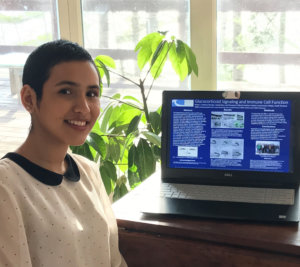
SMCC student Maria Orellana Rosales with a scientific research poster shown on the screen of her computer.
Three SMCC students presented the findings of their research at the state’s largest biological and medical symposium, which was held online because of the coronavirus pandemic.
The MDI Biological Laboratory in Bar Harbor hosted the 47th Maine Biological and Medical Sciences Symposium virtually in late April. The two-day event ― which shines the spotlight on Maine’s future biomedical workforce ― featured 53 undergraduate, graduate and post-doctoral researchers from 13 Maine academic and research institutions who presented and discussed scientific posters summarizing their research projects.
Representing SMCC were students Maria Orellana Rosales, David Glass and Ben Clifford, who presented a poster titled Glucocorticoid Signaling and Immune Cell Function. The poster was the product of research conducted during a week-long short course at MDI Biological Lab in January attended by 11 SMCC students and two faculty members.
Although the symposium was a marked change from the usual in-person conferences, there was plenty of live interaction and feedback through the online conferencing platform Zoom.
“It was exciting to see the title of our poster listed among so many interesting studies,” Rosales said. “It felt like I was part of Maine’s scientific community.”
SMCC faculty members Daniel Moore, Elizabeth Ehrenfeld and Lareen Smith also participated in the event.
“Having the accessibility to the presentations on Zoom and posters online was a great success,” Smith said. “The presentations had a more inclusive feel compared to sitting in an auditorium. It also allowed for extra time spent on reading each student’s poster, noticing details that I may have otherwise missed at an in-person poster session.”
Two SMCC alumni, Daniel Singer and Julie Moulton, also presented posters about research in labs where they now are working.

